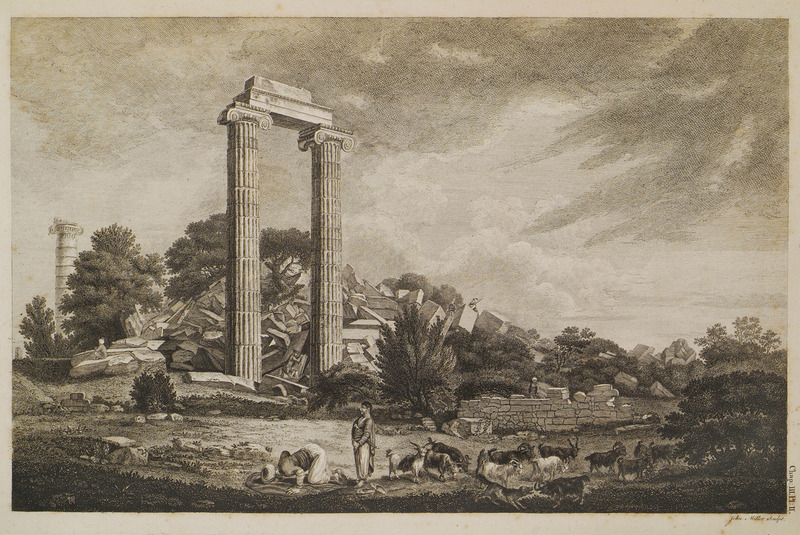By Glenn Maffia
A rather curious snippet of information came to my attention of a rumour circulating that the three standing columns at the Temple of Apollo are recent reconstructions.
I found that quite laughable. Though then realised these ill-informed pieces of nonsense could impair people’s judgement of this magnificent site. So I decided to counter these deceits with solid evidence; both from literary and pictorial sources through the ages.
Nothing evades time
Even though the Temple of Apollo ceased operating as a polytheist centre of worship after the edict of Theodosius I in 381, proclaiming Christianity as the sole religion of the Byzantine state, I feel certain the old believers continued their rites clandestinely.
Archaeological evidence from another Oracular temple, not far away, at Claros, attests to some polytheist religious activity continuing past this date. One can only speculate as to the timeframe these activities stretched into.
No doubt any earthquake damage or merely the aging of the structure could not be rectified openly. Thus the temple did fall to natural causes and the profession of lime makers who burnt the marble from the temple walls and columns to help manufacture lime to be used as mortar in the stone building trade. Nothing evades time, or nature.
The coming of the adventurers
Humans continued upon the passage of time and by the beginning of the Renaissance a level of inquisitiveness and knowledge flourished, leading to travel to seek out the finds of the ancient Graeco-Roman world.
The first literary source we have was penned by an Italian humanist and antiquarian Cyriacus di Ancona (also known as Ciriaco de’ Pizzicolli, 1391-1453/55). Restlessly itinerant he travelled endlessly, making copious notes along his journeys.
The resulting six volumes of ‘Commentarii’ (Commentaries) were never published but fortuitously were circulated in manuscript form. Visiting the Temple of Apollo at Didyma in 1446 he recalled that most of the temple was still standing intact.
Though by the end of that century another traveller noted that most of the structure had fallen to the ground after violent earthquake activity.
No doubt the lime burners were toiling in their trade during the intervening centuries though there was still plenty to see and record when the Dilettanti Society of London came visiting in 1764-65 under the direction of Richard Chandler.
During the visit, his team’s artist, William Pars, produced a watercolour painting showing the three existing columns in situ, as we see them today.

A second expedition was mounted during 1811 when William Gell led the British team. Both expeditions recorded many facets of the temple, and Gell produced a detailed map of the entire area along the Didyma end of the Sacred Road and within the immediate vicinity of the temple itself.
Later, during 1833-34, Felix Marie Charles Texier passed through on his many wanderings, a person as deeply immersed into inquiry as Cyriacus before him. Texier also executed a watercolour composition of the standing columns.

These two watercolour paintings alone are solid evidence the three remaining columns have withstood the ravages of time and a shaking earth.
The ‘professionals’ arrive
Further excavation expeditions include Charles Newton’s1858 tour where he rediscovered a series of statues placed upon the Sacred Road, the Chares statues.
Newton had to delay his intended departure to wait for the Sultan’s ‘firman’ (official permission) to arrive from Istanbul before departing to Britain with the statues. These now sit in Room 13 of the British Museum.
Fourteen years later, 1872, the first of the French teams arrived led by Olivier Rayet and Albert Thomas, they published their findings in ‘Le temple d’Apollon Didymèen in 1876.
Following them, in 1895-96, were Bernard Haussoullier and Emmanuel Pontremoli’s excavation project. This was extraordinary in that they used dynamite in an attempt to remove the fallen masonry from the Adyton (internal courtyard).
I have seen photos of this curious and destructive method of excavation, they are owned by an owner of one of the bars close to the temple. Even after that sudden jolt to their stability, the three columns remain resolute in their stubbornness in defiantly continuing to stand. These two impatient gentlemen also published, in 1904, “Didymes. Fouillies de 1895 à 1896”.
In 1905/6 the German archaeologists were permitted to excavate in a more scientific and civilised manner. Their director Theodor Weigand, in a caustic aside, pronounced, “We shall use a trowel”, and held aloft a French made trowel.

The Germans, save during the two World Wars, have been here ever since. Last year the German team erected scaffolding around the three columns after drone photography revealed alarming cracks appearing towards the top of the columns.
This maintenance work could have possibly been erroneously construed as being the completion of a rebuilding scheme. It was nothing of the sort.
These three columns have stood firm and true since their inception 2,000 years ago.